

Processing Seagrass Samples
![]()
Objective: To describe the amount of plant matter in manatee habitats
Because manatees feed on seagrass, it is important to measure
the amount of it in a particular area. Biomass is defined as the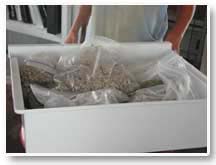 amount of plant matter (primary productivity) in an area and measured in
units of weight such as grams or ounces.
amount of plant matter (primary productivity) in an area and measured in
units of weight such as grams or ounces.
The task is to separate the biomass samples collected with a coring device refered to affectionately as "The Beast" into the following five categories:
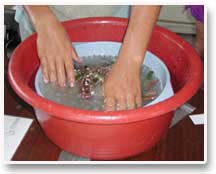 "Above
ground live seagrass" is that part of the plant that lives above
the sea floor. "Below ground live seagrass" is that part of
the plant that lives below the sea floor. "Dead seagrass" is
any seagrass material that is dead. "Calcareous algae" are algae
that build a calcium carbonate skeleton from minerals in the sea water.
When these algae die, their skeletons are broken down into sand-sized
disks.
"Above
ground live seagrass" is that part of the plant that lives above
the sea floor. "Below ground live seagrass" is that part of
the plant that lives below the sea floor. "Dead seagrass" is
any seagrass material that is dead. "Calcareous algae" are algae
that build a calcium carbonate skeleton from minerals in the sea water.
When these algae die, their skeletons are broken down into sand-sized
disks.
Any live algae that are found are separated from the calcareous tests.
Calcareous tests are the segments of the skeleton of dead algae. The calcareous
tests are discarded, but the live algae are kept as part of the sampling
material. "Other biomass" is anything organic that is not either
seagrass or calcareous algae such as a worm, a piece of wood, or a leaf.
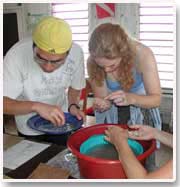 To
begin, the volunteers first lay out pieces of cardboard on the table labeled
with the five categories. The sample is dumped into a tub of fresh water
for sorting. The volunteers comb through the
To
begin, the volunteers first lay out pieces of cardboard on the table labeled
with the five categories. The sample is dumped into a tub of fresh water
for sorting. The volunteers comb through the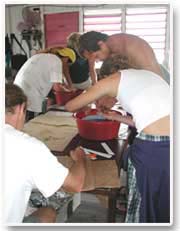 sample using their fingers to separate the material into the five categories.
As pieces are identified they are laid out on the appropriately labeled
cardboard. Any epibionts is scraped from the live seagrass leaves with
a table knife and discarded. Epibionts are other plants and animals that
live on the seagrass blades.
sample using their fingers to separate the material into the five categories.
As pieces are identified they are laid out on the appropriately labeled
cardboard. Any epibionts is scraped from the live seagrass leaves with
a table knife and discarded. Epibionts are other plants and animals that
live on the seagrass blades.
Once the material has been separated into the five categories, each pile
is placed in a foil bin and dried. Before this however, the foil bins
are labeled with the category of the sample, the location where the sample
was collected, the cardinal direction of the sample location, the date,
the team number, and the volunteers' names. The foil and paper are weighed
and recorded. Then the samples are placed in the appropriate bin and weighed
again. All weights are recorded on the data log sheet. The bins are then
placed in the drying oven.
 When
the samples are dry, after about two days, they are weighed in the bin
again, and the weights of the bins and labels subtracted to determine
the actual dry weight of the samples.
When
the samples are dry, after about two days, they are weighed in the bin
again, and the weights of the bins and labels subtracted to determine
the actual dry weight of the samples.
Seagrass processing is tedious work. Sorting out all the tiny bits from
the seagrass requires a long stint of bending over the table and peering intently at small samples
of material. The team thinks that sitting on the boat all day in the hot
sun, tired and hungry might not be so bad after all!
long stint of bending over the table and peering intently at small samples
of material. The team thinks that sitting on the boat all day in the hot
sun, tired and hungry might not be so bad after all!
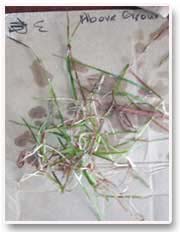 |
Above ground live seagrass |
 |
Calcareous algae |
 |
Below ground live seagrass |
 |
Tests |
 |
Recording on the data sheet |